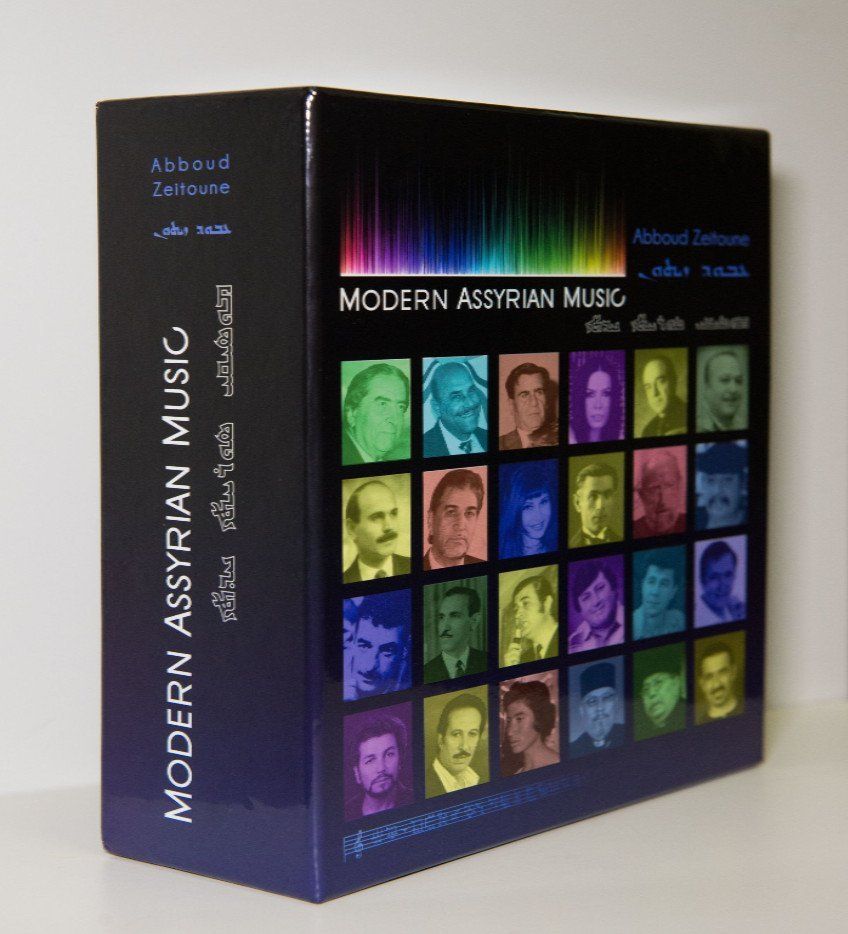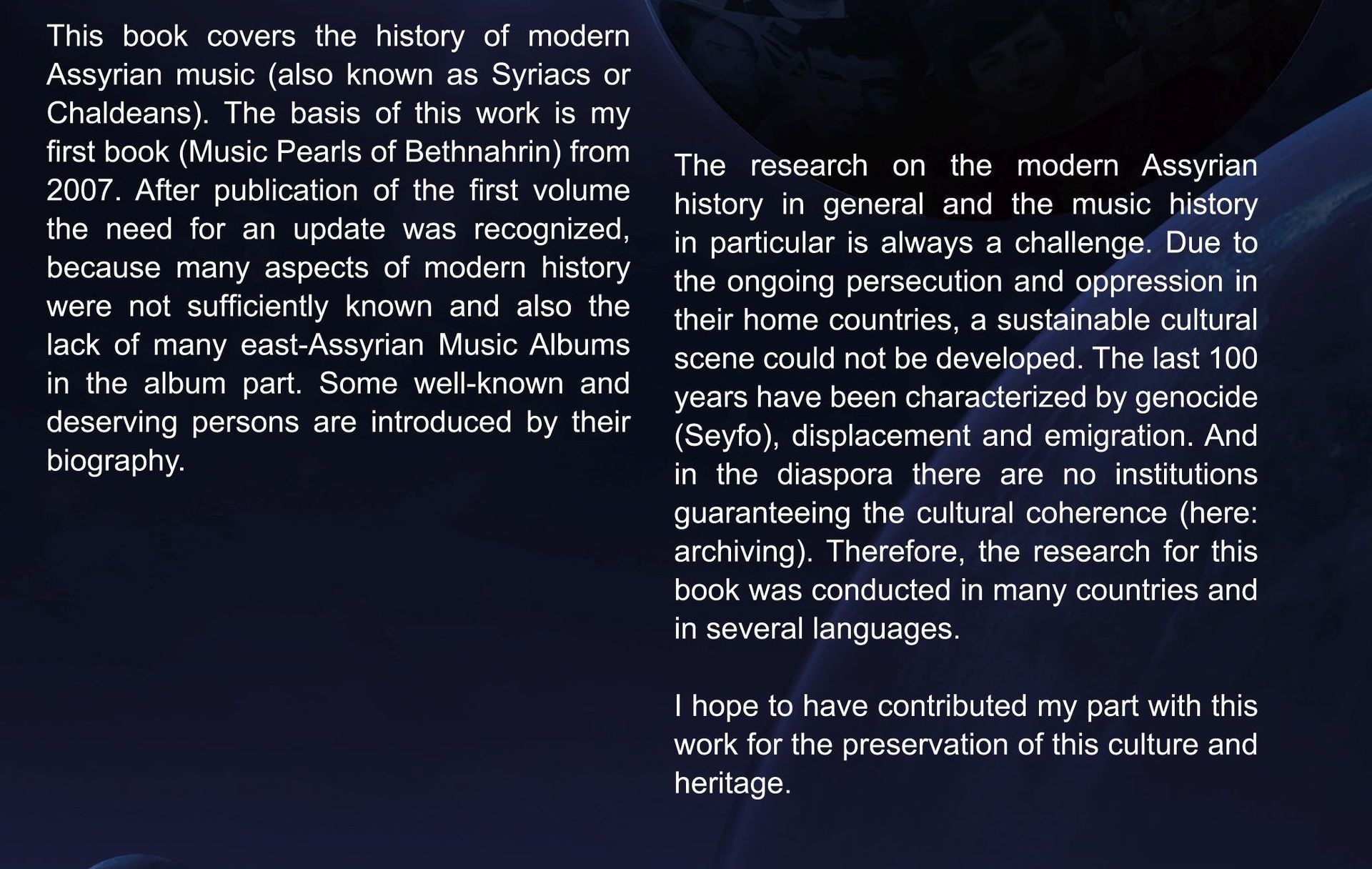


Introduction
The publication of the first book (Music Pearls of Bethnahrin) in 2007 was a first attempt to
catalogue modern Assyrian music. The reaction encouraged me to continue in this area (see a
selection of statements on page 6).
With this work I succeeded in raising the attention of many interested friends. We could
establish a network of archivists in many countries. This is also the basis of the present work.
Because of the collective passion and thirst for knowledge of this network many works and
findings from our recent history (last 100 years) have been lifted out of the woodwork.
The main part of west Assyrian music works was documented in the first book while the eastern
Assyrian part was underrepresented. This gap is now closed with this new book. A significant
part for this was possible due to the very good support of friends like Moneer Cherie and
Romeo Hanna (both Sydney / Australia). My friend Hanibal Romanos (Sweden) worked also
intensively on this project. Therefore I would like to express my thanks for their help. Also the
archive of the Modern Assyrian Archive Foundation (MARA) made a major contribution for this
work. The collected material was very supportive to my research. I especially thank Tomas Isik
from the MARA team for his support.
Due to worldwide dispersal it is very difficult to locate and identify our cultural heritage of the
last decades. Particularly in the homelands these items were forgotten or destroyed because of
wars, massacres and displacements. By reading old magazines I tried to gain clues about the
music of that time. I was partially surprised how little people used their own language for
singing. This finding applies to both western and eastern Assyrians.
At the same time I'm glad, because on these publications, I came across rarities. There was for
example the record of Elias Boyaji from 1929.The initiative to search for this record was an
advert in the “Hekmtho” magazine from the year 1930. We were successful in this case.
Because of the worldwide network we could localise a copy of this record in Boston. Also the
oldest known records in Assyrian were discovered in an advert in the New Assyria magazine
from 1917. Actually four years later we could get three of at least four records (Joseph & Anna
Yonan). These records were sold by an American who bought them on a flea market in an
eBay auction.
The described knowledge was used as a reason to update the main article about modern
Assyrian music. Additionally the music scene outside the home countries was considered. In
the research framework I recognized musical notation in several publications and decided to
dedicate a chapter to it.
This work is although an update the first book but does not include already documented of
complete details. A consideration of this would go beyond the scope. Therefore this book can
be seen as a second part. However an updated overall album list is printed at the end of the
book.
The focus of my work has been on the documentation of the music scene. I normally don’t
analyse the music as such. Nevertheless I give an insight by the selection of priorities in the
main article and the chosen biographies.
The current situation of our music scene is not sufficient. There are rarely traditional releases.
languages (predominately Arabic).
The basis for the development of the Assyrian music should be already released productions
and of course the rich heritage in our church. These pearls should be researched by our
musicians and taken care of.
catalogue modern Assyrian music. The reaction encouraged me to continue in this area (see a
selection of statements on page 6).
With this work I succeeded in raising the attention of many interested friends. We could
establish a network of archivists in many countries. This is also the basis of the present work.
Because of the collective passion and thirst for knowledge of this network many works and
findings from our recent history (last 100 years) have been lifted out of the woodwork.
The main part of west Assyrian music works was documented in the first book while the eastern
Assyrian part was underrepresented. This gap is now closed with this new book. A significant
part for this was possible due to the very good support of friends like Moneer Cherie and
Romeo Hanna (both Sydney / Australia). My friend Hanibal Romanos (Sweden) worked also
intensively on this project. Therefore I would like to express my thanks for their help. Also the
archive of the Modern Assyrian Archive Foundation (MARA) made a major contribution for this
work. The collected material was very supportive to my research. I especially thank Tomas Isik
from the MARA team for his support.
Due to worldwide dispersal it is very difficult to locate and identify our cultural heritage of the
last decades. Particularly in the homelands these items were forgotten or destroyed because of
wars, massacres and displacements. By reading old magazines I tried to gain clues about the
music of that time. I was partially surprised how little people used their own language for
singing. This finding applies to both western and eastern Assyrians.
At the same time I'm glad, because on these publications, I came across rarities. There was for
example the record of Elias Boyaji from 1929.The initiative to search for this record was an
advert in the “Hekmtho” magazine from the year 1930. We were successful in this case.
Because of the worldwide network we could localise a copy of this record in Boston. Also the
oldest known records in Assyrian were discovered in an advert in the New Assyria magazine
from 1917. Actually four years later we could get three of at least four records (Joseph & Anna
Yonan). These records were sold by an American who bought them on a flea market in an
eBay auction.
The described knowledge was used as a reason to update the main article about modern
Assyrian music. Additionally the music scene outside the home countries was considered. In
the research framework I recognized musical notation in several publications and decided to
dedicate a chapter to it.
This work is although an update the first book but does not include already documented of
complete details. A consideration of this would go beyond the scope. Therefore this book can
be seen as a second part. However an updated overall album list is printed at the end of the
book.
The focus of my work has been on the documentation of the music scene. I normally don’t
analyse the music as such. Nevertheless I give an insight by the selection of priorities in the
main article and the chosen biographies.
The current situation of our music scene is not sufficient. There are rarely traditional releases.
Alarmingly a high number of artists produce only live albums (mostly known folkloric songs)
they record at weddings or parties. There is a dramatic standstill in the western part. There are
very rare productions in recent years and beside that many singers release albums in foreignlanguages (predominately Arabic).
The basis for the development of the Assyrian music should be already released productions
and of course the rich heritage in our church. These pearls should be researched by our
musicians and taken care of.

